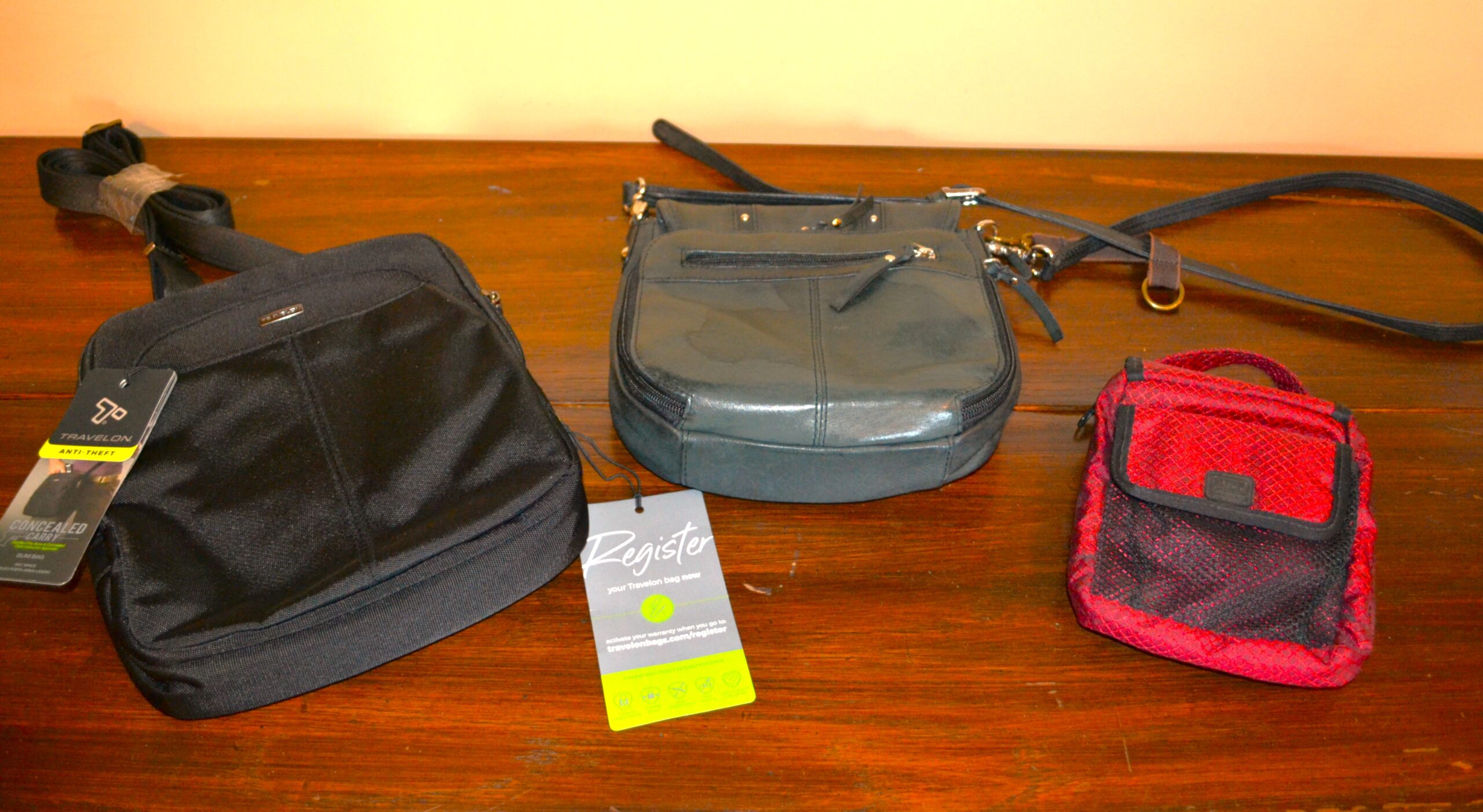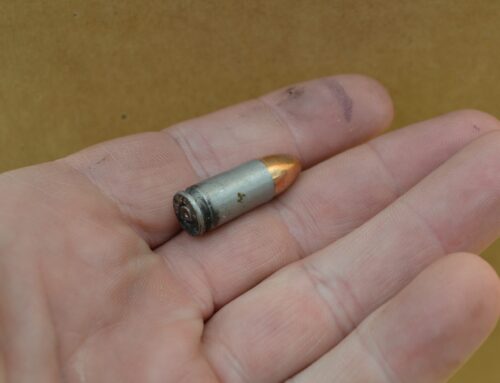“The art of teaching is the art of assisting discovery.” – Mark Van Dore
I just completed a three-day FlexCCarry® [Flexible Concealed Carry] Instructor certification course taught by the legendary Vicki Farnam, and it was quite an eye-opening experience!
Vicki and her outstanding assistants, Marty Rudd and Gloria Krauklis, spent three days teaching us the ins and outs of off-body carry, as well as how to effectively instruct the students that employ it.
Vicki brought two large duffels of gun purses, cross body and shoulder bags, as well as unisex covert carry bags. We were not only shown the products, but required to pick up, study, and provide our negative and positive critiques of each. With one bag at a time, we spent a full two days installing holsters, running dry and live fire drills, and following up with evaluations and comments. This was invaluable!
As one who has carried his firearms on the waist for over 30 years, having the opportunity to inspect, set up, and then deploy 20 different off-body carry options has, for me, converted the academic into practical application.
I’ve handled a plethora of off-body carry options during 23 years of teaching, however, the majority have been at gun shops or trade shows. Rarely did they include a holster and blue (prop) gun, and less so an opportunity to draw from them with live a gun on a range.
One reason I’ve not spent more time with it is because quality bags are expensive. I simply wasn’t able to invest in 20 different options to practice with and have available for students. However, I’ll be remedying that as soon as possible!
Notes On “Off-Body” Carry
“Off-body” is a bit of a misnomer. A bag equipped with a strap and slung over the shoulder is most certainly ON one’s body, just like a slung rifle would be. Vicki suggests the use of the term Daily Go Bag, instead. I think with many that may conjure up images of the emergency “go bag” that contains water, power bars, and other necessities. The word bag is also contradictory when it comes to day planners and other carry methods that aren’t bags in the conventional sense. Off-Body Carry is also an industry term that, like it or not, and accurate or not, is understood by most discussing it.
For now, I’m using off-body to refer to any carry method where the holster is not directly attached to the person, such as belt, shoulder, and ankle holsters, as well as FlashBangs, bellybands, etc… I may change the term I use at some point in the future.
There are positives and negatives to off-body carry (as there are with on-body carry.) However, the negatives are in no way “deal breakers”, or anything we can’t train around. The drawstroke requires two hands (support hand stabilizing the bag) and a bit of alteration from the conventional to avoid covering the support hand with the muzzle. Took some getting used to, but didn’t take long.
With all things in this business, everything is a tradeoff. In order to get something, we have to give up something. For example, if we want a smaller gun, we’ll be carrying less ammunition than in a full-size gun. Nothing is perfect! However, there are some off-body carry “issues” bantered about in the industry that aren’t actually issues.
As a generalization, there are two negative myths commonly repeated regarding off-body carry.
1) It takes too much time to draw from a bag – Belt holsters are always faster.
2) It’s too easy to set the bag down and forget it.
Regarding the first, it depends on the defensive situation, the bag, and the person carrying it (proper training.) What I found is that there are off-body carry options that were (in some cases) as fast, or even faster, than draw from my primary belt holster.
There were some that I wasn’t able to perform well with – But, what works for me isn’t necessarily what works for everyone, and vice versa. What’s important is that there were multiple solutions that did work for me, as there will be for others
Regarding the second – Few women ever forget their purse. All of the stories I have personal knowledge of where guns were left behind in bathrooms (at least 5) were the result of men doing so. Leaving guns behind in public spaces is a 95% man problem. Thus, male Instructors attempting to dissuade off-body carry to women because “they might forget their bag somewhere” is not only incorrect but also insulting. Men leave far more guns behind when exercising conventional belt carry – perhaps some humility on our part is in order.
Of course, when we carry a loaded gun in a detachable container there’s heightened responsibility to prevent said container from falling into unauthorized hands. It goes with the territory, but still well within the abilities of conscientious adults.
Thoughts for Instructors
The market for off-body carry bags is enormous. There aren’t just 1, 10, or 20 manufacturers, there’s so many it’s like trying to name every company presently producing AR15’s. Yet, somehow, they are all managing to stay in business! Which means far more people are choosing to carry off-body than most of us want to admit.
I know that two of the most important women in my life practice it daily. And I also know there are a metric ton of SOCOM and plain clothes Law Enforcement engaging in it, as well.
For large-framed, relatively healthy males, belt holster carry remains the common method. However, they are no longer the majority of new people exercising their right to self-defense with a firearm.
With over half of the states now Constitutional carry (and shall issue permits existing almost everywhere else) the opportunity for self-protection with a firearm is an option for just about every good citizen. Thus, we’re seeing a massive uptick in numbers of women, elderly, and disabled taking advantage of it.
Those three demographics all present unique challenges when to comes to carrying a gun on the waist, or even directly on their person. They need carry options (flexibility.) And they need proper training from skilled Instructors who won’t belittle their carry choices.
If we have the words Firearm Instructor on our business card, I’d suggest that off-body carry instruction is part of our job.
As Instructors, are we really going to turn away a student in a wheelchair because “we only carry guns on our hips”? Are we not going to teach medical personnel who are mandated to wear scrubs? How about the person who just underwent abdominal surgery? The woman who is 6-months pregnant? Have we considered the chauffeur or executive protection agent who can’t access their pistol with a seat-belt on? Have we considered the frustration of those attempting belt carry in the winter with three layers of clothing over their gun? How about a utility locator wearing coveralls in February?
Do they not deserve our attention? Of course they do.
And, perhaps our reluctance to take on the challenge has been partially due to our own lack of knowledge, as an Instructor certification for off body carry has never available. Well, there is now, because Vicki and her colleagues stepped up and created the FlexCCarry® student and Instructor courses.
This class is not just highly recommended, but should be mandatory for all CCW Instructors!
~Frank
“A comfort zone is nothing but a plush lined coffin. We die there.” – Author paraphrasing Stan Dale
Vicki’s FlexCCarry® book may be found at: Amazon
Visit the FlexCCarry® website: www.flexccarrysolutions.com





